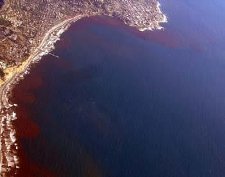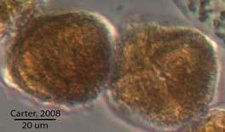What are Harmful Algal Blooms?
The rapid growth of cells of one or several species of phytoplankton can
form an algal bloom. While blooms are often harmless and can be beneficial to marine and freshwater ecosystems, some algal blooms can have negative impacts to the environment, human health, or the economy and are thus termed Harmful Algal Blooms (HABs). Mechanisms that classify a particular organism as harmful can be physical (gill irritation, viscosity and gelatinous barriers which lead to gill clogging and death), large blooms leading to anoxia, and/or production of algal toxins

Aerial photograph of a dense bloom of Lingulodinium polyedra off southern California in the summer of 2005. The dark red discoloration of the water is why this is often called a “Red Tide.” Photo taken by Eddie Kisfaludy.
Why are HABs important?
Some harmful algae produce potent toxins which cause illness or death in humans and marine organisms—fish, seabirds, manatees, sea lions, turtles, and dolphins are some commonly affected animals. Other types of harmful algae are nontoxic to humans but cause harm to fish and invertebrates .
HABs can have major negative impacts on local economies, and a recent conservative assessment estimates that HABs occurring in marine waters alone have an average annual impact of $82 million in the U.S.
What is a Red Tide?
Red Tide is a common name for a phenomenon where blooms of certain algal species, which contain red-brown pigments, cause the water to appear red, brown, or orange. Many red tides are harmless, and others may cause harm through toxin production or other mechanism.

Dense concentrations of these cells, Lingulodinium polyedra, cause the discoloration of the ocean. This species produces bioluminescence at night when the cells are agitated.
What are phytoplankton?
Phytoplankton are microscopic, single celled plants that live in the ocean. Most species of phytoplankton are not harmful and are primary producers at the base of the food web. Many phytoplankton, like land plants, use the energy from the sun and carbon dioxide to produce sugar and oxygen through photosynthesis. This process requires special photosynthetic pigments to capture the solar energy. Chlorophyll-a is the most common pigment found in phytoplankton and is used to as a proxy to determine the biomass of primary producers.
There are several thousand species of phytoplankton. The two major groups that have representative HAB species in California are diatoms and dinoflagellates. Diatoms are unicellular organisms that have yellow-brown chloroplasts and cell walls made of silica. Dinoflagellates are unicellular algae with two flagella which enable them to swim. Dinoflagellates can be autotrophic (photosynthetic) and/or heterotrophic (consume other organisms).
